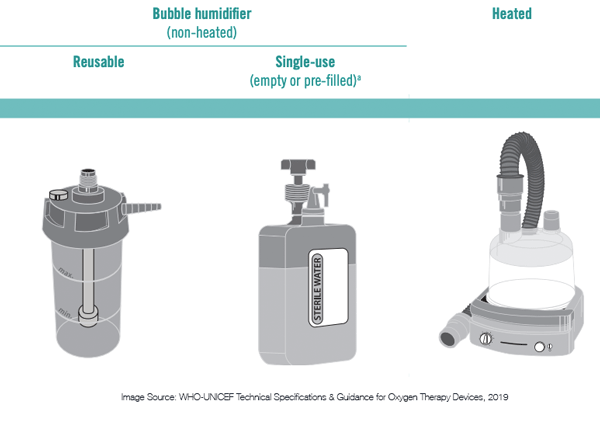Oxygen FAQ
Up to date, expert answers to frequently asked questions (FAQ) about oxygen supply systems, respiratory care and pulse oximetry written by OCC & collaborators.
Humidification
The amount of water consumed per day by active humidification depends upon several factors including minute ventilation requirements and the ability of a specific humidification system to reach and maintain the goal of providing between 33 to 44 mgH2O/L of ventilation. Under ideal conditions (use of a heated wire circuit to prevent rainout) at low (5L/min), average for critical-illness (10L/min) and high (15 L/min) minute ventilation demands, the estimated daily consumption would be approximately the following: For the gas conditioning criteria of 33-44 mgH20/L estimated H2O consumption would be approximately 250-300, 500-600 and 700-1000 mL/day, respectively.
- Passive systems:
- Non-heated bubble humidifiers – are simple, low cost devices used with low flow oxygen delivery devices like nasal cannula or nasopharyngeal catheters. These devices require sterile or distilled water and are generally not efficient. Some may be reusable or single-use only.
- Heat and Moisture Exchangers (HME) are simple, low cost components used with mechanical ventilators and CPAP or NIPPV devices. HMEs trap moisture and prevent it from being lost into the ventilator. They are not reusable.
- Efficacy of these devices drop over time, causing increased resistance. Many manufacturers suggest a change every 24 hours, but studies have shown that an unsoiled device in some circumstances can be used for several days (Ricard et al, AJRCCM 2000; Thomacot et al, CCM, 2002).
- Signs of an increase in resistance include an increase in PIP but no change in Plateau pressure or a prolonged expiratory flow time.
- The most common cause of HME partial occlusion or rise in resistance is from pulmonary edema fluid or blood. Mucus generally clumps in a dependent portion of the device without increasing resistance appreciably. (Davis et al Crit Care Med. 2000)
- Read more about how often HMEs should be replaced
- Hygroscopic Condenser Humidifiers (HCH) are functionally the same as HMEs (though have a slightly different mechanism). In the past, HME types were separated based on the additional treatment of the media. An HME relied solely on physical principles whereas the HCH included treatment of the media with a hygroscopic salt (LiCl, now mostly CaCl). An HME may be made from foam, paper or other substance that helps water condense (the earliest were aluminum). At present, the reality is that most HME devices also take advantage of the hygroscopic salt (check manufacturer’s specifications to confirm this). In theory, if one were to push the media out of an HME then touch it to the tip of the tongue – it would be very salty (DO NOT TRY THIS). The moisture efficiency of an HME or HCH is dependent on its size, media density and salt treatment. HMEs may be referred to as type I (adult) and type II (pediatrics), which differ in deadspace and functional tidal volume range.
- Active systems:
- Active heated humidification systems use a reservoir of water and a heating element. Inhaled air is typically passed through this heated chamber to become humidified before it enters the patient. Ideally, the inspiratory limb of the circuit contains a heating element to preserve the heat and humidification and to keep excess water from condensing and pooling in the circuit.
- These systems require power, a supply chain for sterile or distilled water, and additional disposable tubing.
- Active heated humidification systems use a reservoir of water and a heating element. Inhaled air is typically passed through this heated chamber to become humidified before it enters the patient. Ideally, the inspiratory limb of the circuit contains a heating element to preserve the heat and humidification and to keep excess water from condensing and pooling in the circuit.

Moisture present in patients’ lungs is rapidly lost at high breathing rates.
When breathing dry air, cilia stop functioning properly (in a matter of hours – Hirsch et al J Appl Physio 1975). When the moisture level becomes low, mucous in the patient’s lungs can become thick and hard, and quickly block the patient’s airways, or the endotracheal tube, stopping airflow.
Additionally, heat is rapidly lost to non-humidified air.